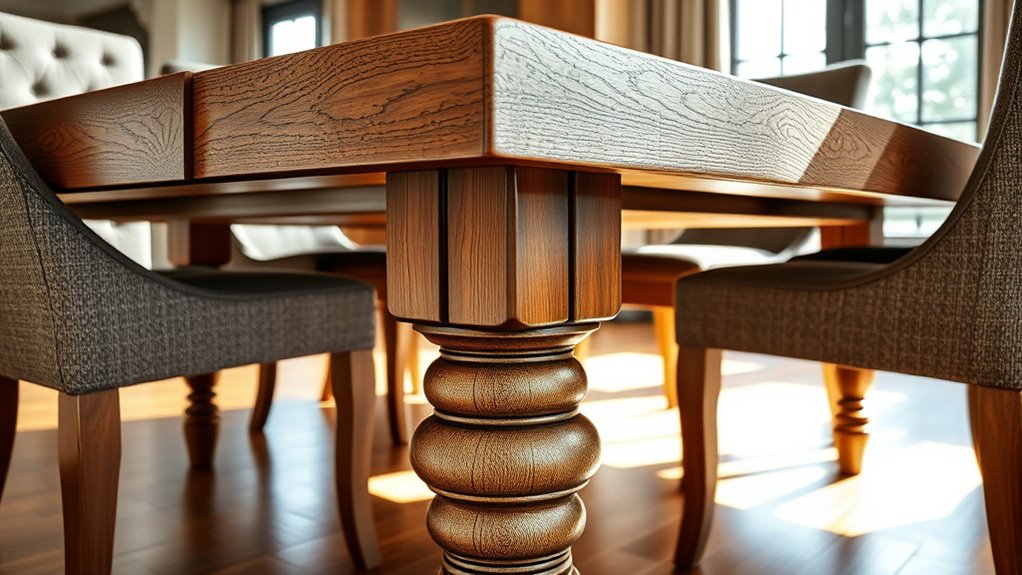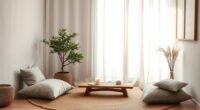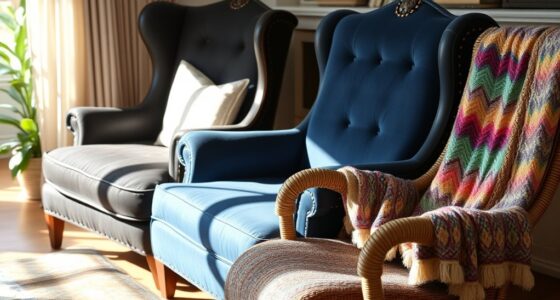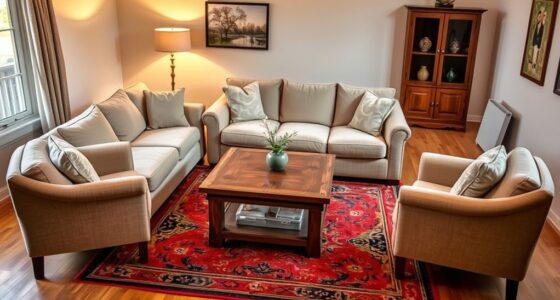To select durable furniture for long-term use, focus on high-quality materials like solid wood or metal, which resist warping and damage. Check the construction for strong joinery, reinforced corners, and sturdy hardware. Opt for timeless designs that won’t easily go out of style, and choose fabrics with reliable finishes or upholstery that can withstand wear. Proper maintenance and care will prolong its lifespan, and the following tips will help you make the best choices.
Key Takeaways
- Choose furniture made from solid, durable materials like hardwood or metal with high-quality finishes.
- Inspect construction techniques, favoring traditional joinery and reinforced corners for added stability.
- Opt for timeless designs with versatile features to ensure style longevity despite changing trends.
- Select upholstery with high-performance fabrics or natural leathers that resist wear, stains, and fading.
- Follow proper maintenance practices, including protective measures and regular care, to extend furniture lifespan.
Prioritize Solid Wood and Quality Materials

Choosing furniture made from solid wood and high-quality materials is a smart way to guarantee long-term durability. Solid wood, like oak, maple, or walnut, offers durability that resists warping, dents, and scratches, ensuring your furniture stays beautiful for decades. When you select quality furniture built with these durable materials, you benefit from superior structural integrity and resistance to moisture damage compared to particleboard or MDF. Plus, opting for reclaimed or sustainably sourced wood provides eco-friendly options without sacrificing strength or longevity. The dense grain structure of solid wood enhances its ability to withstand daily wear, making it a cost-effective choice over time. Incorporating natural weather indicators into your understanding can help you better plan for environmental conditions that might affect outdoor furniture. Prioritizing solid wood ensures your furniture remains sturdy, attractive, and functional for years to come.
Inspect the Frame and Joinery for Strength
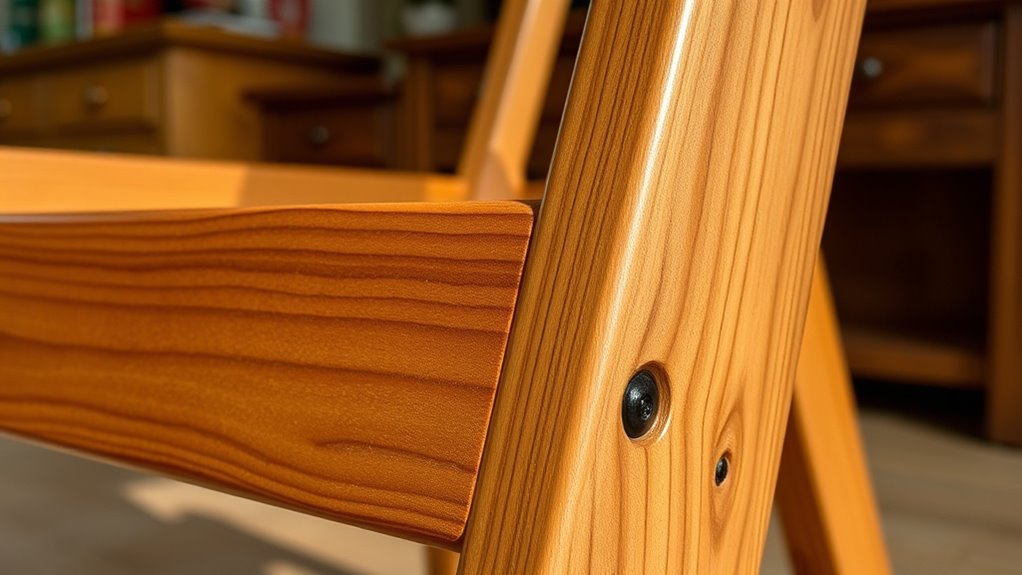
To guarantee your furniture will last, it’s vital to carefully inspect the frame and joinery for strength. Look for a sturdy frame constructed from quality materials like kiln-dried hardwood or metal, which resist warping and cracking. Check for traditional joinery methods such as dovetail joints, mortise-and-tenon, or tongue-and-groove, as these offer superior joint strength. Reinforced corners with dowels, screws, or corner blocks add extra stability and prevent wobbling. Test the furniture by applying slight pressure to see if joints hold firm—loose connections indicate weakness. Solidly built furniture often features tightly fitted joints, smooth surfaces, and no gaps. Use the table below to evaluate key aspects of frame construction:
| Aspect | What to Look For | Why It Matters |
|---|---|---|
| Dovetail joints | Tight, interlocking fit | Superior joint strength |
| Reinforced corners | Dowel or screw reinforcement | Increased stability |
| Frame construction | Kiln-dried hardwood or metal | Long-lasting durability |
| Joint strength | No looseness or gaps | Overall sturdiness |
| Stability | Firm, wobble-free feel | Ensures long-term use |
Additionally, assessing the material quality of the frame can significantly impact the longevity of your furniture. Being aware of manufacturing standards can also help ensure the durability of your purchase. For added reassurance, consider checking for certified quality marks or warranties that demonstrate adherence to industry standards. Regular maintenance and proper care can extend the lifespan of your furniture even further. Properly assembled furniture also contributes to its overall durability and safety.
Choose Durable and Well-Fitted Upholstery Fabrics
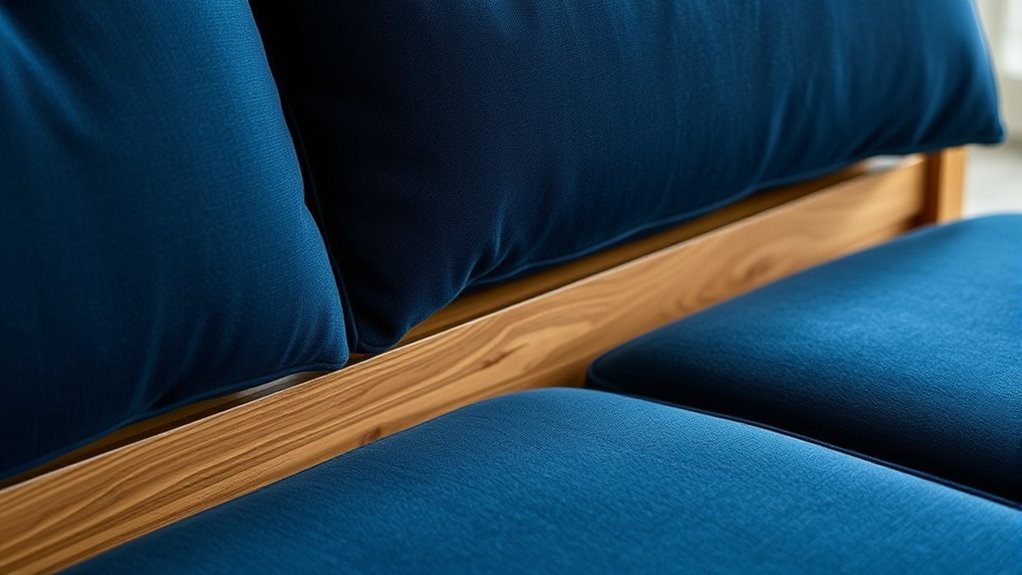
When selecting upholstery fabrics, prioritize high-performance materials like microfiber, leather, or tightly woven textiles that resist stains and wear. Using natural materials can also help your furniture blend seamlessly with your interior decor. Choosing treated or stain-resistant fabrics adds extra protection, helping your furniture stay looking new longer. Additionally, selecting fabrics that are eco-friendly aligns with sustainable practices valued by many consumers. Opting for fabrics with water-repellent coatings can further enhance durability and ease of maintenance.
Fabric Material Durability
Durable upholstery fabrics are essential for guaranteeing your furniture stands up to daily wear and tear. High-performance fabrics like microfiber, leather, and tightly woven textiles offer excellent wear resistance and fabric longevity. Leather ages gracefully, developing a patina that enhances its look over time, making it highly durable for long-term use. Synthetic blends such as polyester or acrylic tend to wear out faster and are more prone to pilling or fraying. Fabrics treated with stain-resistant coatings or sealants add an extra layer of protection against spills and dirt, prolonging the life of your furniture. Properly fitted upholstery, with secure seams and durable backing, prevents sagging or tearing. Selecting fabrics with high tensile strength can further enhance durability and ensure your furniture maintains its appearance over the years. Choosing well-fitted, durable upholstery fabrics ensures your furniture remains attractive and functional for years to come.
Stain and Wear Resistance
Choosing upholstery fabrics that resist stains and wear is essential for maintaining your furniture’s appearance over time. Look for stain-resistant fabrics, such as microfiber, leather, or tightly woven textiles, which offer excellent wear resistance and durability. Leather develops a beautiful patina with age and is naturally resistant to spills and stains when properly cared for. Treated fabrics with stain-resistant coatings or Scotchgard provide an extra layer of fabric protection against spills and dirt, making maintenance easier. Synthetic blends like polyester and acrylic are especially durable, resisting pilling and snagging. Regular maintenance, including prompt spill cleanup and suitable cleaning products, helps extend the lifespan of your furniture, ensuring long-lasting furniture that remains attractive and functional. Incorporating fabrics with low environmental impact can also contribute to more sustainable furniture choices. Additionally, selecting fabrics with air purifying properties can improve indoor air quality and create a healthier living environment. Moreover, fabrics that incorporate antimicrobial treatments can help prevent the growth of bacteria and mold, further enhancing their longevity and hygiene. Using anti-stain finishes can provide an extra safeguard against everyday accidents and spills, enhancing overall durability. To further protect your investment, consider professional upholstery treatments that reinforce fabric resilience against daily wear and tear.
Assess the Construction Techniques and Hardware
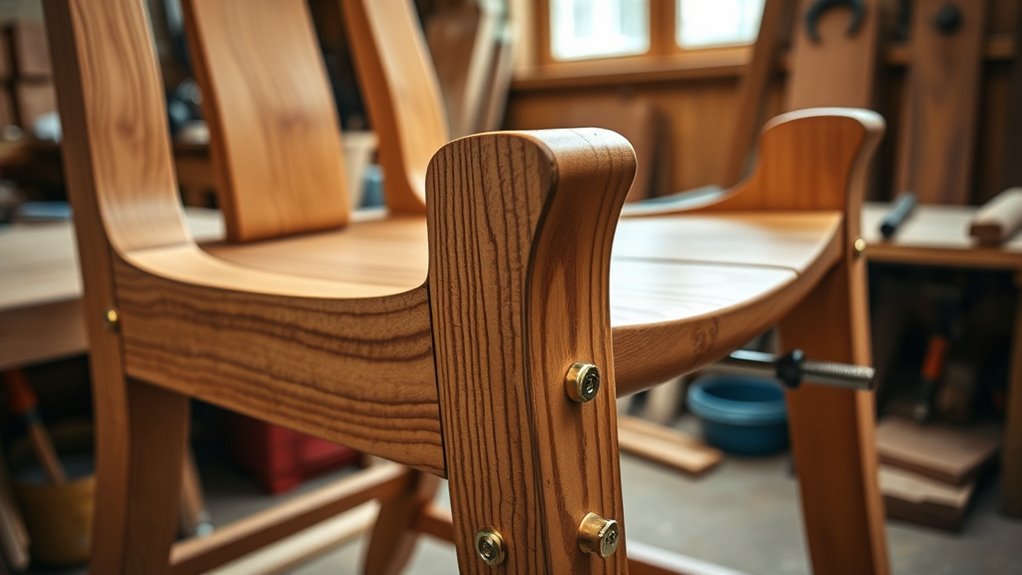
Evaluating the construction techniques and hardware of furniture is essential for guaranteeing long-term durability. Focus on joinery techniques like dovetail, mortise-and-tenon, and tongue-and-groove joints, which offer superior strength and stability. Growth mindset encourages manufacturers to adopt innovative assembly methods, ensuring the furniture remains resilient over time. Reinforced joints, such as corner reinforcements, doweled, or screwed connections, prevent loosening and wobbling over time. Traditional assembly methods using screws, bolts, and strong adhesives generally provide better longevity than staples or glue alone. Check the hardware quality—solid metal hinges and full-extension, soft-close drawer glides are signs of reliable operation and durability. Additional reinforcements, like corner blocks and reinforced backings, help maintain structural integrity, especially during heavy or frequent use. Incorporating durable materials in hardware selection further enhances the furniture’s lifespan. Furthermore, examining the manufacturing standards employed can reveal the overall quality and expected longevity of the furniture piece. For added assurance, inspecting the assembly techniques firsthand can help identify potential weak points before purchase.
Consider the Overall Design and Timeless Style
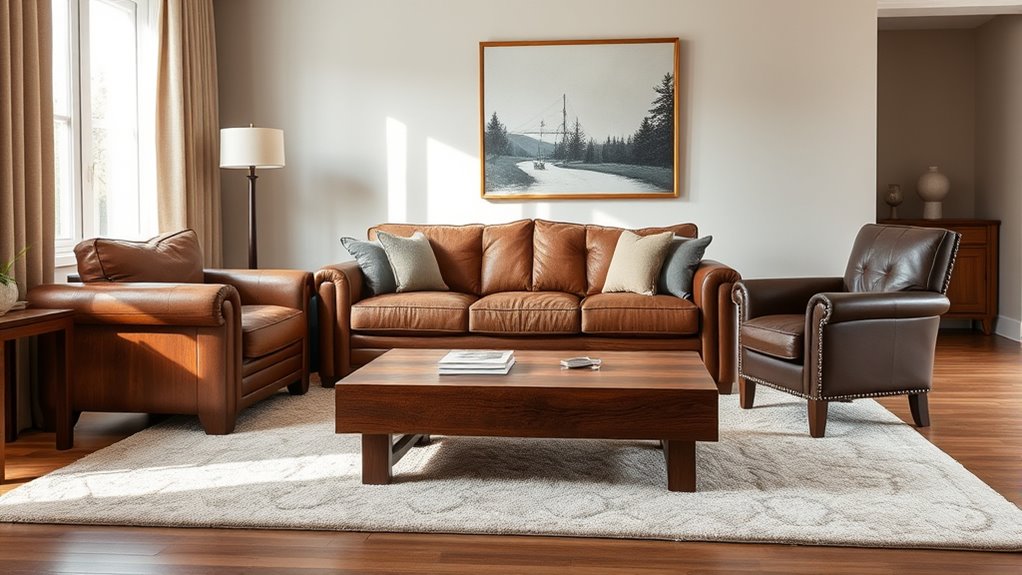
Choosing furniture with a timeless design guarantees it stays stylish for years to come. Focus on versatile elements like neutral tones and classic silhouettes that complement various decor styles. Incorporating durable materials can also enhance the longevity of your furniture, ensuring it withstands everyday use and remains attractive over time. Selecting pieces with rustic lighting or vintage features can add character while maintaining durability, making your furniture both functional and aesthetically pleasing. Additionally, understanding ethical hacking principles can help you protect your smart furniture from potential cybersecurity threats, ensuring both physical and digital security. Being aware of precious metals as alternative investments can further diversify your assets and protect your wealth against market volatility. This approach helps your furniture remain relevant and durable, even as trends change, especially as market volatility encourages alternative investments like gold to diversify your assets.
Enduring Style Preferences
When selecting furniture for long-term use, focusing on timeless styles guarantees your pieces remain attractive through changing trends. Choose designs with simple lines, minimal ornamentation, and neutral tones that blend seamlessly with any decor. Classic silhouettes like a solid wood dining table or a tufted sofa embody enduring style and resist obsolescence. Prioritize high-quality materials and traditional craftsmanship to ensure durability and lasting appeal. These choices create durable furniture that withstands wear and maintains its beauty over decades. By investing in pieces with a timeless design, you’ll enjoy versatile furniture that adapts to evolving interior themes without needing frequent updates. Using vetted product reviews can help you identify furniture that combines style with durability.
Versatile Design Elements
Incorporating versatile design elements into your furniture guarantees your pieces remain stylish and functional for years to come. Opt for timeless design that features classic silhouettes and neutral tones, ensuring your furniture stays relevant regardless of changing trends.
Choosing versatile furniture with simple, clean lines made from durable materials like solid wood or metal enhances longevity and adaptability. Classic elements such as tapered legs and rounded edges contribute to a timeless aesthetic that resists obsolescence.
Evaluate Finishes and Protective Coatings
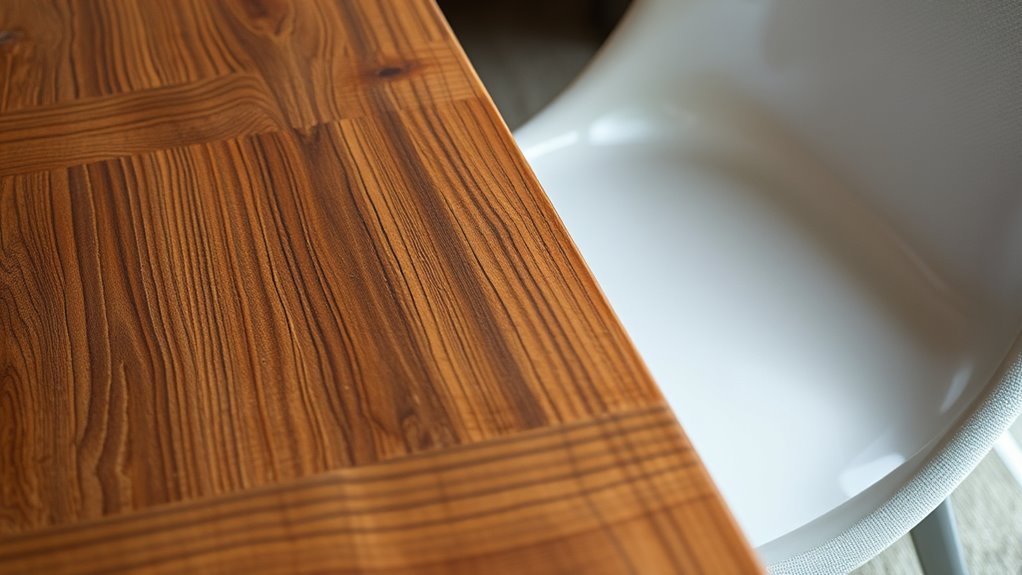
Evaluating finishes and protective coatings is essential to guarantee your furniture withstands daily wear and tear. High-quality coatings like polyurethane, lacquer, or catalyzed varnishes form a durable barrier that resists scratches, stains, and spills.
Assessing finishes ensures furniture durability and resistance to scratches, stains, and spills.
Hand-applied finishes often reflect meticulous craftsmanship, offering thicker, more resilient protection than spray-on options.
Metal furniture benefits from powder-coated or galvanized finishes that prevent rust and extend lifespan, especially outdoors.
Proper sealing helps prevent moisture penetration, chipping, and fading, preserving the furniture’s aesthetic appeal over time.
When appraising finishes, consider these factors:
- Resistance to scratches and stains
- Moisture penetration prevention
- Quality of protective coatings
- Craftsmanship and application method
- Suitability for intended environment
Maintain and Care for Your Furniture Properly
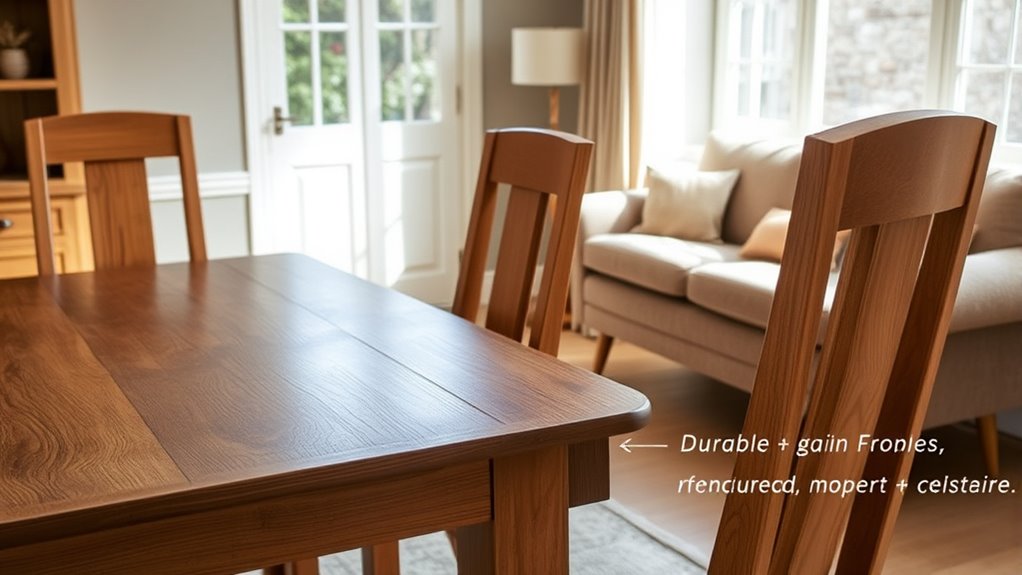
Proper maintenance and care are key to ensuring your furniture remains beautiful and functional for years to come. By following simple steps, you can prevent damage and maintain its appearance. Use appropriate cleaning products and follow care instructions for fabrics, leather, and finishes. Protect wooden surfaces from moisture and scratches with coasters, placemats, and felt pads. Avoid direct sunlight to prevent fading and drying. Reapply protective finishes as recommended to preserve durability. Remember, consistent furniture maintenance extends its life and keeps it looking new.
| Action | Tool/Material | Purpose |
|---|---|---|
| Dust and clean | Soft cloth, gentle cleaner | Prevent buildup, surface damage |
| Protect surfaces | Coasters, felt pads | Prevent scratches and moisture |
| Follow care instructions | Manufacturer’s guidelines | Maintain fabric, leather, finishes |
| Avoid sunlight exposure | Curtains, positioning | Prevent fading and drying |
| Reapply protective finishes | Protective treatments | Preserve appearance and integrity |
Frequently Asked Questions
How Do I Choose Long Lasting Furniture?
When choosing long-lasting furniture, you look for solid hardwoods like oak, maple, or walnut, which resist warping. You check for quality joinery, such as dovetail or mortise-and-tenon joints, for stronger connections.
You pick pieces with reinforced frames, sturdy legs, and durable hardware. For upholstered items, you prefer leather or high-performance fabrics that resist stains and fading.
Regular cleaning and protective finishes also help extend your furniture’s lifespan.
What Type of Furniture Lasts the Longest?
When considering which furniture lasts the longest, focus on solid hardwood pieces like oak, maple, or walnut, as they resist warping and age beautifully.
Look for furniture with traditional joinery, such as dovetail or mortise-and-tenon joints, which are more durable.
Metal frames made from stainless steel or wrought iron also stand out for longevity.
Choosing high-quality upholstery with sturdy frames and fabrics guarantees your furniture stays in top shape for years.
What Is the Most Durable Material for Furniture?
When choosing the most durable material for furniture, you should consider solid hardwoods like oak, maple, or walnut. These woods resist scratches, dents, and warping over time.
Metal frames made of stainless steel or wrought iron also last long, especially in busy environments.
For upholstery, genuine leather or high-performance fabrics hold up well against stains and wear.
Tempered glass surfaces are another durable option for tabletops, resisting scratches and impacts.
How Can You Tell if Furniture Is High Quality?
They say “you get what you pay for,” and that’s true for furniture too. To tell if it’s high quality, look for solid joinery like dovetails or mortise-and-tenon joints, and check the frame—kiln-dried hardwood is best.
Reinforced corners, well-executed craftsmanship, and durable upholstery materials also signal quality. Don’t forget to research brands with good reviews and warranties—these are signs you’re investing in furniture that’ll stand the test of time.
Conclusion
By choosing solid wood, sturdy construction, and timeless designs, you’re building furniture that lasts like a trusted old friend. Remember to inspect every joint and fabric, and keep up with proper care to guarantee your furniture remains a beacon of durability. Think of your pieces as investments in comfort and style—like planting seeds that bloom for years to come. With these tips, your furniture will stand strong through time’s storms and sunshine alike.
